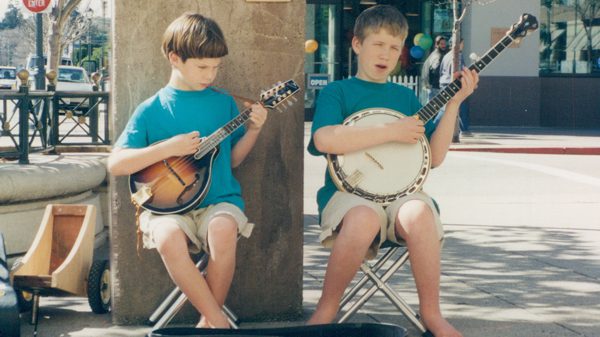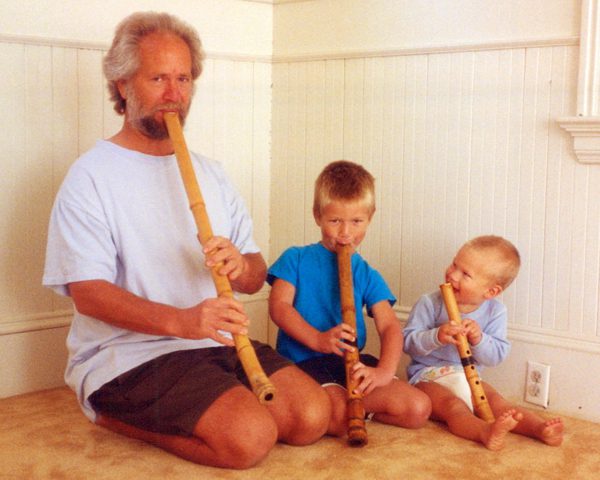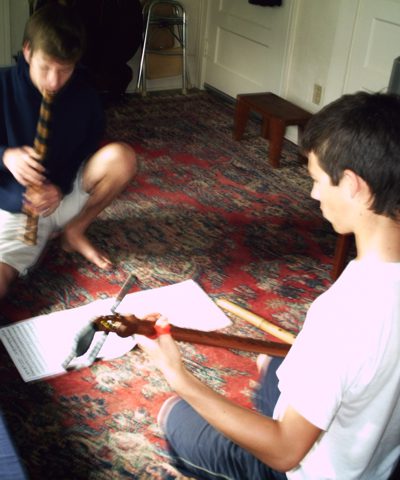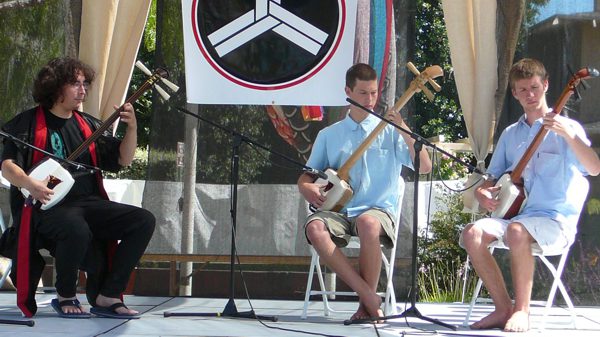As presumptuous as it sounds, in order to learn about the ways of Bachido, we first have to learn a little bit about Kyle Abbott, the founder of Bachido. (That’s me!)

Don’t worry, it will all become clear
Though not being professional musicians themselves, my parents always wanted music to be part of family life. Soon after my brother and I were born, they put various instruments (tenor guitar, keyboard, bongos, recorder, etc) around the house for us to toy and experiment with. When our parents played folk music together (Johnny Cash, Carter Family songs, etc), we would pick up our instruments and just experiment as they played.
Our parents didn’t teach us music, but through listening to them play, my brother and I discovered how the song’s melodic flow correlates with the pitches on the fretboard. Just like learning to walk and talk, music is something we learned simply by imitation and experimentation. No official teachers needed.

Busking on the mall with my brother, Luke (Webmeister of Bachido)
Since then, we learned banjo, guitar, mandolin, bass, fiddle and many more instruments the same way – experimenting and stumbling until our fingers and ears got comfortable with the instrument. Was it hard? Nope! A common misconception is that when learning a new instrument, you are starting from the beginning each time. Actually, this is not the case!
After learning your first instrument and discovering the connection between pitches and the strings, that awareness directly carries over to the next stringed instrument you learn. Similar to learning a romance language like Italian, you’ll find similarities which make learning French or Spanish much easier. The same is true for stringed instruments. It’s all about discovering the connections!

Music was always a part of the family tradition
Though I primarily play shamisen now, my musical upbringing was heavily rooted in bluegrass. We had a family band for 12 years where we regularly performed for charity on the mall. Though bluegrass wasn’t exactly my favorite style, it was something we did together as a family.
A cool point was that by learning shamisen while regularly playing bluegrass, the shamisen experience was influencing my mandolin style, and vice versa! (I like to think of it as musical cross-pollination!)

Starting Shamisen
My father studied shakuhachi in Japan when he lived there in the early ’70s. I started early, but needless to say, it took a long time to finally make a sound.

Practicing for the big recital
When I started learning how to play shakuhachi, he gave me tapes of San Kyoku (Ensembles of shakuhachi, koto and shamisen) to learn songs from. Hearing the gentle sound of the koto, I told my father that was an instrument I wanted to learn. His response was, “You should try shamisen first. You already play banjo so it might come naturally.”
We were fortunate enough that a family friend let us borrow her shamisen to start learning. At that time, there were no resources available to learn from, so I just started the same way I learned the other instruments – striking strings and pressing notes until it started to make sense!

Practicing Jiuta pieces with my brother
Meeting Kevin
As fate would have it, Kevin Kmetz started playing shamisen on the Pacific Garden Mall (a few blocks from my house!) shortly after I began self-teaching myself shamisen. Surprisingly, I didn’t approach him until a few years later.
At the time, I was only interested in traditional Japanese folk songs and slow jiut music, whereas Kevin played energetic tsugar style shamisen (which is too recent to be considered traditional). I felt tsugaru was the “young people’s music” (I was 14, mind you) and that was something I just wasn’t interested in, so I didn’t introduce myself. (I was probably shy)

Kevin busking on the streets of Santa Cruz
At age 15, I felt comfortable with the shamisen but I didn’t know know any shamisen-specific parts or songs. I would mimic the shakuhachi melody whenever playing jiuta pieces (Kuro Kami, Chi Dori no Kyoku, etc). I eventually grew frustrated of this and yearned to learn a shamisen-specific songs or melodies. I didn’t care if it was tsugaru songs, so I finally decided to meet Kevin Kmetz!
One day, I walked up to Kevin and as an ice breaker, said “what tuning are you in?” (smooth!) He was super nice (as always) and let me try his big tsugaru shamisen. Impressed with what I could already do, he offered to teach me songs and techniques.
Kevin taught basic shamisen techniques (hajiki, sukui, etc) and form over the next few months. Rather than force me to focus on solely technique (which many strict teachers do), he focused on increasing my repertoire, knowing that bachi technique would naturally improve as I kept playing. (A point I am very appreciative of.)

Kevin, Luke (my brother) and I playing at the 2007 Japanese Culture Fair
At that time, I was insistent on solely playing traditional songs. I had an internal need for structure/tradition to balance out my wild and creative personality (I assume), so Kevin willingly taught traditional folk songs. The ironic twist is that as I grew up, that need for structure had gone away and I was ready to learn modern pieces and even start a metal band! Unfortunately, by that time Kevin had already moved to Japan. (Oh the humanity!)
